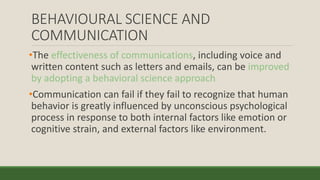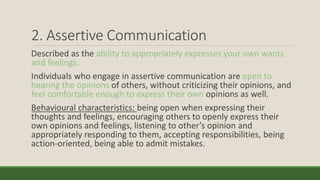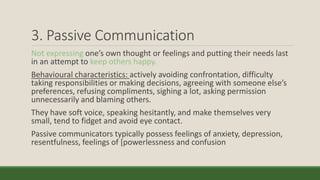TOPIC 1 INTRO TO BEHAVIORAL SCIENCE.pdf
- 1. TOPIC 1: INTRODUCTION TO BEHAVIORAL SCIENCE BEHAVIORAL SCIENCE 1: COMMUNICATION BP 1012 / NS 1212
- 2. LEARNING OUTCOMES At the end of this lecture, students will be able to: ➢State the definition of behavioural science. ➢Explain the importance of behavioural science ➢Describe the foundation to studying of behavioural science and goal of behavioural science. ➢Describe categories of human behaviour and list the factors that influence human behaviour ➢Explain different types of behavioural communication
- 3. DEFINITION OF TERMS ▪Behaviour: human adjust to their environment. It is a patent way of action ▪Science: this is the body of knowledge based on examination, testing and facts that can be proved. ▪Behavioural Science: study of patent action that can be supported by the facts that are based on examination, testing and evaluation.
- 4. IMPORTANCE OF BEHAVIORAL SCIENCE ➢It serves as a basis of telling why individuals take the actions they take especially at the work place ➢It is a basis of predicting how particular individuals will act under particular circumstances ➢We can derive ways of controlling human behaviour. It is possible or to put it into extinction. ➢Studying behavioural science can serve as a stepping stone to improving quality of life when positive behaviour is discouraged or modified. The individuals involved live a better life ➢Behavioural also determines individual values, communication and outlook in life which are key to conflict resolution, stress management and acceptance of change ➢Behavioural has a direct impact to customer/consumer relations. It will thus affect the performance of organizations.
- 5. GOALS OF BEHAVIORAL SCIENCE Scientific research of behavioural has 4 general goals:
- 6. 1. DESCRIBE •The purpose is to helps better understand and gain better perspectives of what is considered typical and atypical behaviour. •Information collection is by natural observing, surveys, case studies and self- reporting tests. •Once behaviour have been thoroughly documented and described to the smallest detail, researchers can use that information as starting point for explaining the behaviour. •Example: A study to learn more about consumer behaviour. Researcher use market research survey, direct observation and other data collection to gather information on what are people doing when they shop. This gives researcher greater insight into what is really happening in a particular population.
- 7. 2. EXPLAIN •The goal of explaining is to provide answers to questions about why people react to certain ways. •Explanation helps determine why we behave or react in certain ways, or how certain stimuli might affect our mental health, personalities or relationship. •Many scientist have developed numerous theories to explain various human behaviour •Some theories have been debunked or replaced by more recent findings, while others have endured and maintained their acceptance by the scientific community. •Example: psychologist then conducted research to understand why consumer purchase certain items. They might ask questions about why people purchase certain items or what factor motivate them to make certain purchase.
- 8. 3. PREDICT •Once psychologist have better understanding about what happens and why it happens, the information can be use to predict about when, why and how it might happen again in the future. •Successfully predicting behaviour is one of the best way to know if we understand the underlying causes of our action. •Example: looking at consumer behaviour, psychologist would use the information they collected to try predict what consumers will purchase next. Business and marketers often employ consumer psychologists to make such predictions so that they can create products that will appeal to buyers.
- 9. 4. CHANGE •From treating mental illness to enhancing human well-being, changing human behaviour is a huge focus of psychology. •Psychology strives to change, influence, or control behaviour to make constructive and lasting changes in people’s lives. •The goal of change asks “How can I stop this habit?” or “What can I do to be more generous person?” •This final goal can help bring about positive changes in life, such as decreasing additive behaviours, reducing depressive symptoms or improving communication. •Example: Marketers and businesses often use the understanding gained from psychological research to try to influence and persuade buyers to behave in certain ways. For example, they might design advertising campaigns designed to make a message appeal to a target audience. By tailoring their messaging to specifically appeal to a certain type of buyer, those individuals are often more likely to respond.
- 10. FOUNDATIONS/APPROACHES TO STUDYING BEHAVIOUR 1. Biological Perspective This is the search for causes of behaviour in the functioning of genes, the brain, the liver system and the endocrine system. Behaviour can be explained in the underlying physical and biochemical processes 2. Psychodynamic perspective Behaviour can be driven or motivated by powerful inner forces. Human action stems from biological drives and attempt to some conflicts between personal week and societal demands 3. Humanistic perspective The main task for human beings is to strive for growth and development of their potential. Human beings integrate knowledge in their mind, body and system to form behaviour. Behaviour thus becomes the experiences and realization of human potential.
- 11. FOUNDATIONS/APPROACHES TO STUDYING BEHAVIOUR 4. Cognitive perspective Human thought and processes of knowing such as thinking, language, memory and understanding determine behaviour. People act because they think and think because they are human beings. 5. Evolutionary perspective Organisms that are better suited to the environment tend to produce offspring that are more successful than those organisms with poor adaptation. 6. Cultural perspective Cross cultural differences may cause and result too behavioural patterns. People’s perceptions are affected by culture. Culture is the medium of expression and dictates what we learn thus shaping our behaviour.
- 12. SPECTRUM OF BEHAVIORAL SCIENCE ▪Psychology The study of the mind, occurring partly via the study of behaviour. The study of the nature, functions and phenomena of human beings. ▪Sociology The scientific study of society, the study of the development, nature and laws on human society. Sociology also focuses on social stratification, social class, social mobility, religion, law and deviance ▪Anthropology The study of the origins, history, mechanisms and constitution of human cultures
- 13. SPECTRUM OF BEHAVIORAL SCIENCE •Ethology The study of behaviour of non-human species in the natural setting •Ecology Deals with the relations of human beings to their environment and the quantification of this relationship •Epidemiology The study of illness in defined population
- 14. HUMAN BEHAVIOUR ➢Behavior: human adjust to their environment. It is a patent way of action ➢Human behaviour: collection of behaviours exhibit by human beings. ➢Behaviour can be: ➢Conscious or unconscious ➢Overt or covert ➢Voluntary or involuntary
- 15. HUMAN BEHAVIOUR The behaviour of people falls within a range: ◦Common X Unusual ◦Acceptable X outside acceptability The acceptability of behaviour and normativity is evaluated relative to social and moral norms and regulated by various means of social control. Social behaviour is behaviour specifically directed at other people.
- 16. CATEGORIES OF HUMAN BEHAVIOUR There are 4 categories of human behaviour: 1. Behaviour detectability ▪ Behaviour we can detect with our senses (eg see or hear) ▪ Behaviour that cannot be detected by our senses (thinking) 2. Behaviour purposive ▪ Involves action ▪ Goal driven
- 17. CATEGORIES OF HUMAN BEHAVIOUR 3. Behaviour involving performance (or skilled behaviour) ▪ Behaviour that demonstrates skills of various kinds from work to sports 4. Instinctual behaviour ◦ Having to do with anatomical or psychological nature of human ◦ Behaviour in this category is determined by the need or desire to avoid pain and gain pleasure.
- 18. HUMAN BEHAVIOUR INFLUENCE BY: 1.Culture 2.Emotions 3.Ethics 4.Rapport 5.Persuasion 6.Genetics 7.Attitude 8.Values 9.Authority 10.Hypnosis
- 19. RELEVANCE OF BEHAVIOURAL SCIENCE TO HEALTH & MEDICINE: ✓Behavioral and social factors are important in planning for health care with assessment and treatment of both physical and psychiatric disorder ✓Cultural factors play a role in the behavior of the patient and treatment ✓Psychological tests help in the psychiatric diagnosis
- 20. BEHAVIOURAL SCIENCE AND COMMUNICATION •The effectiveness of communications, including voice and written content such as letters and emails, can be improved by adopting a behavioral science approach •Communication can fail if they fail to recognize that human behavior is greatly influenced by unconscious psychological process in response to both internal factors like emotion or cognitive strain, and external factors like environment.
- 21. BEHAVIOURAL COMMUNICATION Behavioural communication is a psychological construct that addresses people’s use of day-to-day behaviour as a form of communication. We are constantly communicating to others our thoughts and feelings, whether we are aware of it or not; by means of indirect messages and behavioural impacts. Our words, our actions, our gestures and posture all send signals.
- 22. 4 BASIC STYLES OF BEHAVIOURAL COMMUNICATION BEHAVIOURAL COMMUNICATION STYLE Aggressive Assertive Passive Passive-aggressive
- 23. 1. Aggressive Communication Defined as an unplanned act of anger which the aggressor intends to hurt someone or something Aggressive communicators typically feel a strong sense of inadequacy, have a lack of empathy and believe the only way to get their need met is through power and control. Behavioural characteristics: putting other down, overpowering other, not showing appreciation, rushing other unnecessarily, ignoring others, not considering other’s feelings, intimidating others and speaking in a condescending manner. Nonverbal behaviour: frowning, critical glares, rigid posture, trying to stand over others, using loud voice and fast speech.
- 24. 2. Assertive Communication Described as the ability to appropriately expresses your own wants and feelings. Individuals who engage in assertive communication are open to hearing the opinions of others, without criticizing their opinions, and feel comfortable enough to express their own opinions as well. Behavioural characteristics: being open when expressing their thoughts and feelings, encouraging others to openly express their own opinions and feelings, listening to other’s opinion and appropriately responding to them, accepting responsibilities, being action-oriented, being able to admit mistakes.
- 25. 3. Passive Communication Not expressing one’s own thought or feelings and putting their needs last in an attempt to keep others happy. Behavioural characteristics: actively avoiding confrontation, difficulty taking responsibilities or making decisions, agreeing with someone else’s preferences, refusing compliments, sighing a lot, asking permission unnecessarily and blaming others. They have soft voice, speaking hesitantly, and make themselves very small, tend to fidget and avoid eye contact. Passive communicators typically possess feelings of anxiety, depression, resentfulness, feelings of [powerlessness and confusion
- 26. 4. Passive-Aggressive Communication It has aspects of both passive and aggressive communication The individual exposes their anger through means of procrastination, being exaggeratedly forgetful and or being intentionally inefficient Behavioural characteristics: sarcasm, being unreliable, frequent complaining, sulking, patronizing, and gossiping In order not to show their anger, they may conceal it with an innocent facial expression.
- 27. Differences of Passive, Assertive and Aggressive PASSIVE ASSERTIVE AGGRESSIVE DEFINITION Communication style where you put the rights of others before your own, minimizing your own self-worth Communication style in which you stand up for your rights while maintaining respect for the rights of others Communication style in which you stand up for your rights but you violate the rights of others IMPLICATION TOOTHERS My feelings are not important I don’t matter I think I am inferior Apologetic We are both important We both matter I think we are equal I statement Your feelings are not important You don’t matter I think I'm superior You statements VERBAL STYLES Overly soft or tentative voice Firm voice Loud voices NONVERBAL STYLES Looking down or away Stooped posture Excessive head nodding Lowered self esteem Anger at self Looking direct Relaxed posture Smooth & relaxed movements Higher self esteem Self respect Staring, narrow eyes Tense, clenched fists, rigid posture Pointing fingers Guilt Anger from others POTENTIAL CONSEQUENCES False feeling of inferiority Disrespect from others Pities by others Respect from others Respect of others Lowered self-esteem Disrespect from others Feared by others.
- 28. THANK YOU!



























